The Advanced tab screen for the Rack iPC Optimized:

The Advanced tab screen for the Rack iPC Universal:

The Advanced tab screen for the Rack iPC Performance:

For details about the Advanced submenus, refer to:
oSecond Super I/O Configuration
oSerial Port Console Redirection
|
Step |
Action |
|---|---|
|
1 |
Save the new BIOS on a USB pen drive. |
|
2 |
Rename the BIOS file to “update.bin”. |
|
3 |
Plug the pen drive into the Rack iPC. |
|
4 |
Enter the BIOS setup. |
|
5 |
In this menu, select the Rack iPC BIOS update option. Result: The BIOS is automatically updated to the new version. |
PCI Subsystem Settings Submenu
The PCI Subsystem Settings submenu:

This table shows the PCI Subsystem Settings option:
|
BIOS setting |
Description |
|---|---|
|
Above 4G Decoding |
Enables or disables 64-bit capable devices to be decoded on above 4 G address space if the system supports 64-bit PCI decoding. |
The ACPI Settings (Advanced configuration and power interface) submenu:

This table shows the ACPI Settings options:
|
BIOS setting |
Description |
|---|---|
|
Power On By Modem |
Enables or disables the power-on by modem. |
|
Enable Hibernation |
Enables or disables hibernation. |
|
ACPI Sleep State |
Optimized: Auto Universal: Auto Performance: S3 only (Suspend to RAM) |
|
Lock Legacy Resources |
Locks legacy resources of the devices. |
|
S3 Video Report |
Optimized: Enables or disables S3 resume for VBIOS. Universal: Enables or disables S3 resume for VBIOS. |
|
PowerOn by Modem |
The system can be awakened from an ACPI sleep by a wake-up signal from a modem that supports this signal. |
|
Power Type |
Optimized: ATX Universal: ATX |
This submenu enables/disables the TPM (TPM 1.1/1.2) setup in BIOS.
The TPM (Trusted platform module) is a secure key generator and key cache management component that enables protected storage of encryption keys and authentication credentials for enhanced security capabilities.
The Trusted Computing submenu:

This table shows the Trusted Computing option:
|
BIOS setting |
Description |
|---|---|
|
TM Support |
Enables or disables TPM if the TPM module is installed on the motherboard. |
The S5 RTC Wake Settings submenu:

This table shows the S5RTC Wake Settings options:
|
BIOS setting |
Description |
|---|---|
|
Wake System with Fixed Time |
Enables or disables system wake-up on an alarm after a fixed time. |
|
Wake System with Dynamic Time |
Enables or disables system wake-up on an alarm after a dynamic time. |
The CPU Configuration submenu for the Rack iPC Universal and Optimized:

Universal Intel(R) Core(TM) i3-2120 CPU @ 3.30 GHz
Optimized Intel(R) Pentium(R) CPU G850 @ 2.90 GHz
The CPU Configuration submenu for the Rack iPC Performance:

This table shows the CPU Configuration options:
|
BIOS setting |
Description |
|---|---|
|
Active Processor Cores |
Allows choosing the number of CPU cores to activate in each processor package. |
|
Limit CPUID Maximum |
Allows limiting the CPUID maximum value. If enabled, legacy operating systems can boot without support for CPUs with extended CPUID functions. |
|
Execute Disable Bit |
Enables or disables the no-execution page protection technology. |
|
Intel Virtualization Technology |
Intel virtualization technology (Intel VT) is a set of hardware enhancements to Intel server and client platforms that provide software-based virtualization solutions. Intel VT allows a platform to run multiple operating systems and applications in independent partitions, therefore, allowing one computer system to function with multiple operating systems. |
|
Hardware Perfectcher |
The processor fetches data and instructions (that are likely to be required soon) from the memory into the cache. This reduces the latency associated with memory reads. |
|
Adjacent Cache Line Prefectch |
Enables or disables the adjacent cache line prefetch feature. |
The SATA Configuration submenu for Optimized Rack iPC:
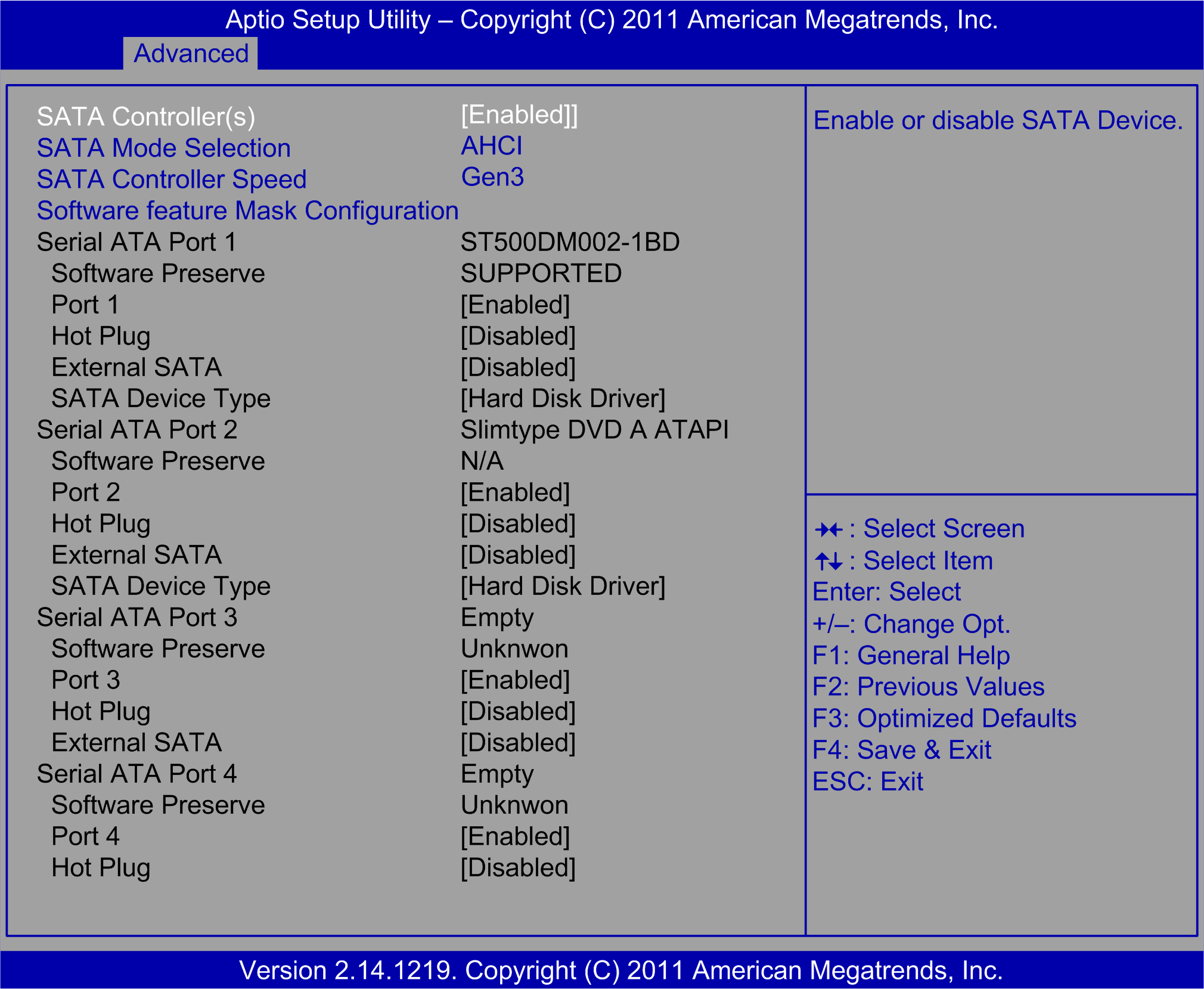
The SATA Configuration submenu for Universal Rack iPC:

The SATA Configuration submenu for Performance Rack iPC:

This table shows the SATA Configuration options:
|
BIOS setting |
Description |
|---|---|
|
SATA Controller(s) |
Enables or disables the SATA function. NOTE: This option is only available if SATA Mode Selection is set to IDE. |
|
SATA Mode Selection |
Universal: The SATA mode can be either IDE or AHCI. |
Intel TXT Configuration Submenu
The Intel TXT Configuration (Intel trusted execution technology configuration) submenu:

This table shows the Intel TXT Configuration options:
|
BIOS setting |
Description |
|---|---|
|
Secure Mode Extension (SMX) |
Enables or disables the Intel secure mode extensions (SMX) technology. |
|
Intel TXT Configuration |
Enables or disables the Intel trusted execution technology. NOTE: This option is only available if the following Intel technologies are enabled: oSecure mode extensions (SMX) oVirtualization technology (VT) oVirtualization for directed I/O (VT-d) |
The AMT Configuration (Intel active management technology configuration) submenu:

This table shows the AMT Configuration options:
|
BIOS setting |
Description |
|---|---|
|
Intel AMT |
Enables or disables the Intel AMT BIOS extensions. |
|
Un-Configure ME |
When disabled, ATM/ME can be unconfigured without a password. When enabled, this action requires a password. |
|
Watchdog |
When set to Enabled, the watchdog timer monitors the time taken for each task performed by a software or hardware: oOS timer [0] oBIOS timer [0] |
The USB Configuration submenu:

This table shows the USB Configuration options:
|
BIOS setting |
Description |
|---|---|
|
USB Devices: |
1 keyboard, 1 mouse, 2 hubs. |
|
Legacy USB Support |
Enables support for legacy USB. The Auto option disables legacy support if no USB devices are connected. |
|
USB 3.0 Support |
– |
|
XHCI Hand-off |
– |
|
EHCI Hand-Off |
This is a work-around for the OS without EHCI hand-off support. |
|
Device reset time-out |
Sets USB mass storage to reset time-out value of the device. |
|
Mass Storage Devices |
Displays USB mass storage device information. |
The SMART Settings submenu:

This table shows the SMART Settings option:
|
BIOS setting |
Description |
|---|---|
|
SMART Self Test |
– |
Super I/O Configuration Submenu
The Super I/O Configuration submenu:

Serial Port 1 Configuration submenu:

This table shows the Serial Port 1 Configuration options:
|
BIOS setting |
Description |
|---|---|
|
Serial Port |
Enables or disables serial port 1. |
|
Change Settings |
Selection of the optional settings for serial port 1. |
Serial Port 2 Configuration submenu:
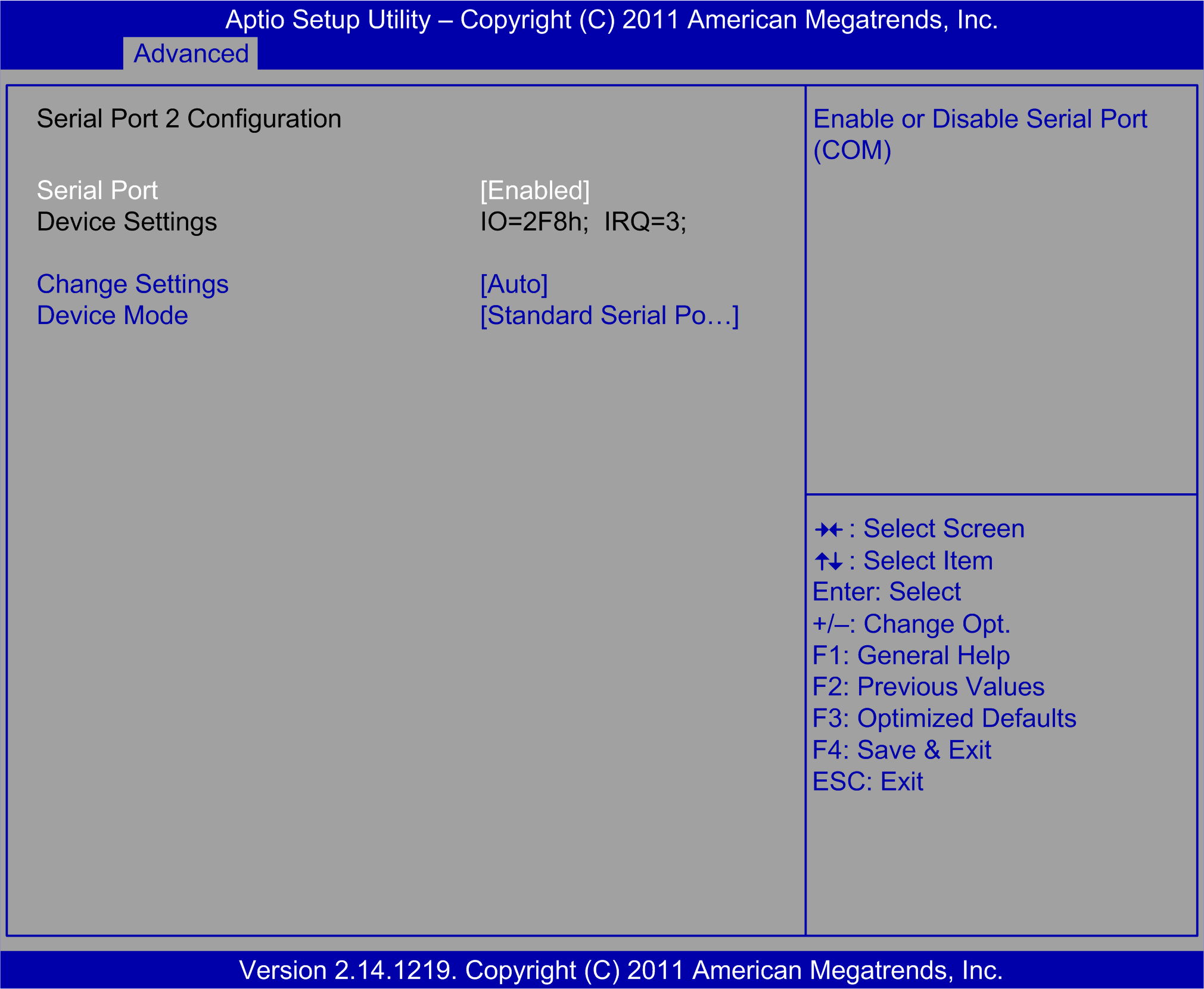
This table shows the Serial Port 2 Configuration options:
|
BIOS setting |
Description |
|---|---|
|
Serial Port |
Enables or disables serial port 2. |
|
Change Settings |
Selection of the optional settings for serial port 2. |
|
Device Mode |
Serial port 2 choices: oStandard serial port mode [Default] oIrDA 1.0 (HP SIR) mode oASKIR mode Performance: STD Printer Mode |
Parallel Port Configuration submenu:

This table shows the Parallel Port Configuration options:
|
BIOS setting |
Description |
|---|---|
|
Parallel Port |
Enables or disables the parallel port. |
|
Change Settings |
Selection of the optional settings for the parallel port. |
|
Device Mode |
Parallel port choices. Optimized: Auto Universal and Performance: ECP and EPP 1.9 Mode |
The AOAC Configuration (Always-ON/Always connected) option screen:
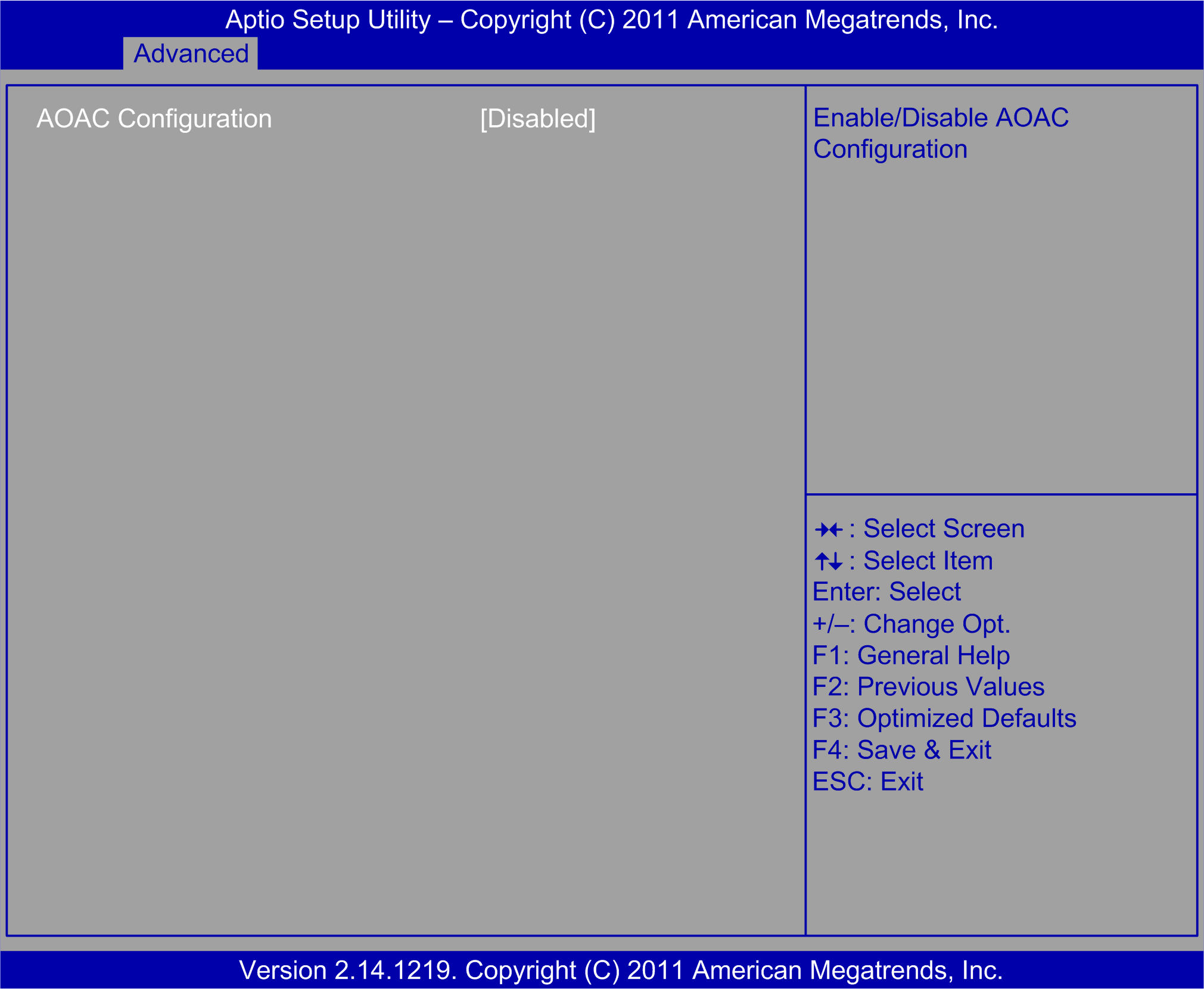
This table shows the AOAC Configuration menu options:
|
BIOS setting |
Description |
|---|---|
|
AOAC Configuration |
Enables or disables the AOAC function. |
The H/W Monitor submenu:
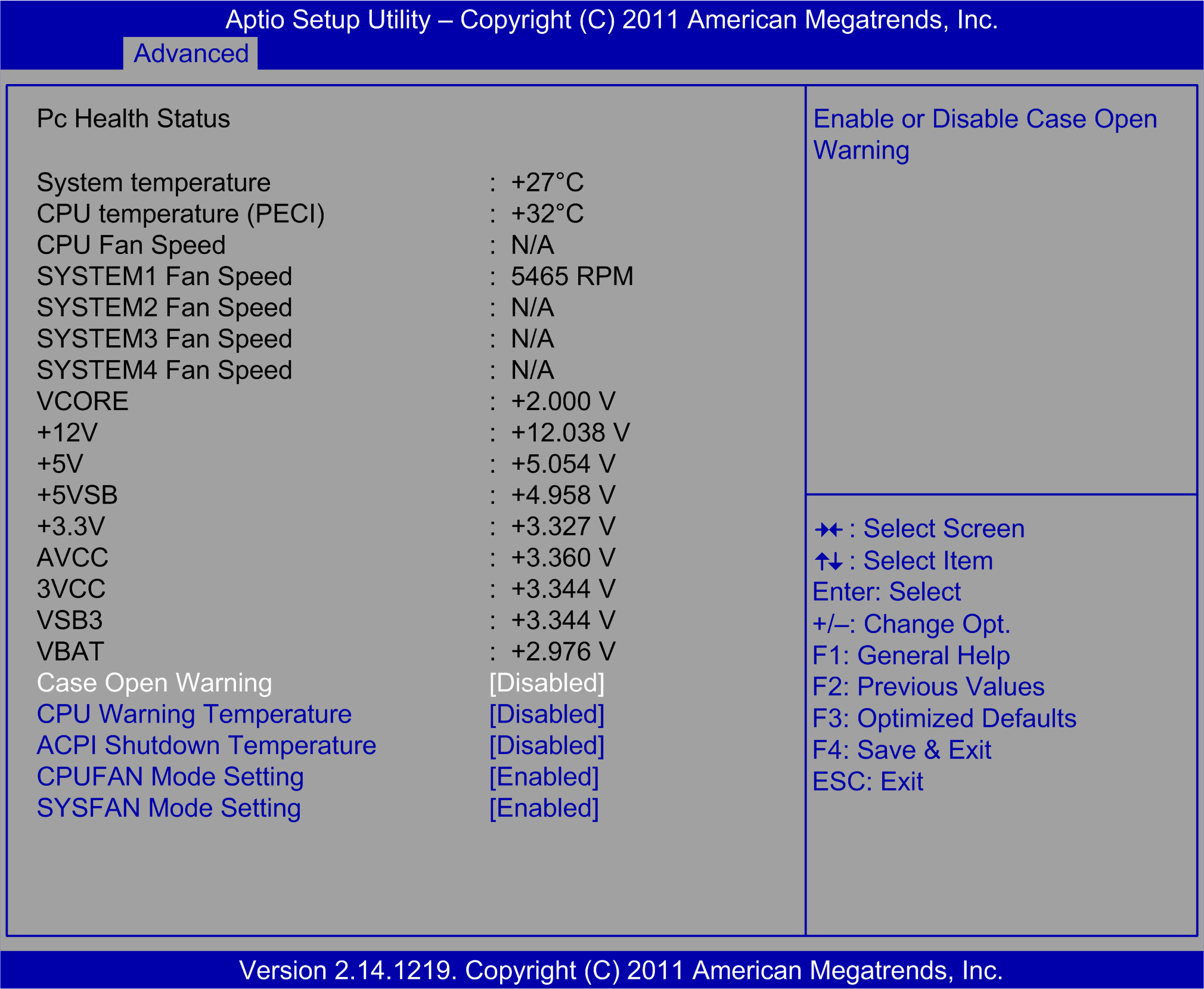
This table shows the H/W Monitor options:
|
BIOS setting |
Description |
|---|---|
|
Case Open Warning |
Enables or disables the chassis intrusion monitoring function. When enabled, if the case is opened, the speaker beeps. |
|
CPU Warning Temperature |
Sets the CPU informing temperature threshold. If the system reaches the informing temperature, the speaker beeps. |
|
ACPI Shutdown Temperature |
Sets the ACPI shutdown temperature threshold. If the system reaches the shutdown temperature, it is automatically shut down by the ACPI OS to protect the system from overheating damage. |
|
CPUFAN Mode Setting |
Enables or disables the CPUFAN mode to SMART FAN. |
|
SYSFAN Mode Setting |
Enables or disables the SYSFAN mode to SMART FAN. |
Second Super I/O Configuration Submenu
The Second Super I/O Configuration submenu:

Serial Port 3 Configuration submenu:

This table shows the Serial Port 3 Configuration options:
|
BIOS setting |
Description |
|---|---|
|
Serial Port |
Enables or disables serial port 3. |
|
Change Settings |
Selection of the optional settings for serial port 3. |
|
Auto Flow Control |
When COM is to set as RS-485, this port supports auto flow control function. |
Serial Port 4 Configuration submenu:
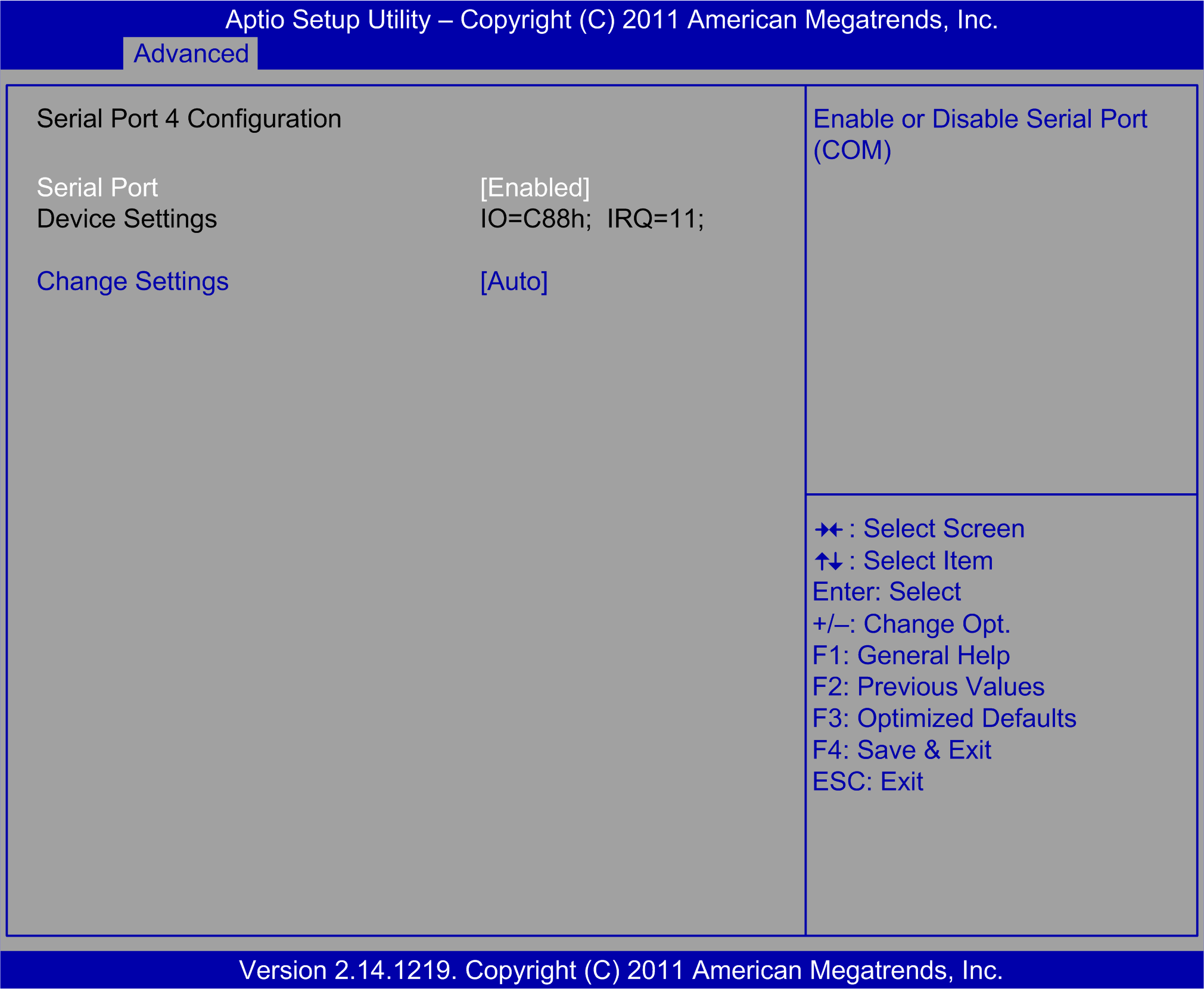
This table shows the Serial Port 4 Configuration options:
|
BIOS setting |
Description |
|---|---|
|
Serial Port |
Enables or disables serial port 4. |
|
Change Settings |
Selection of the optional settings for serial port 4. |
Serial Port 5 Configuration submenu:
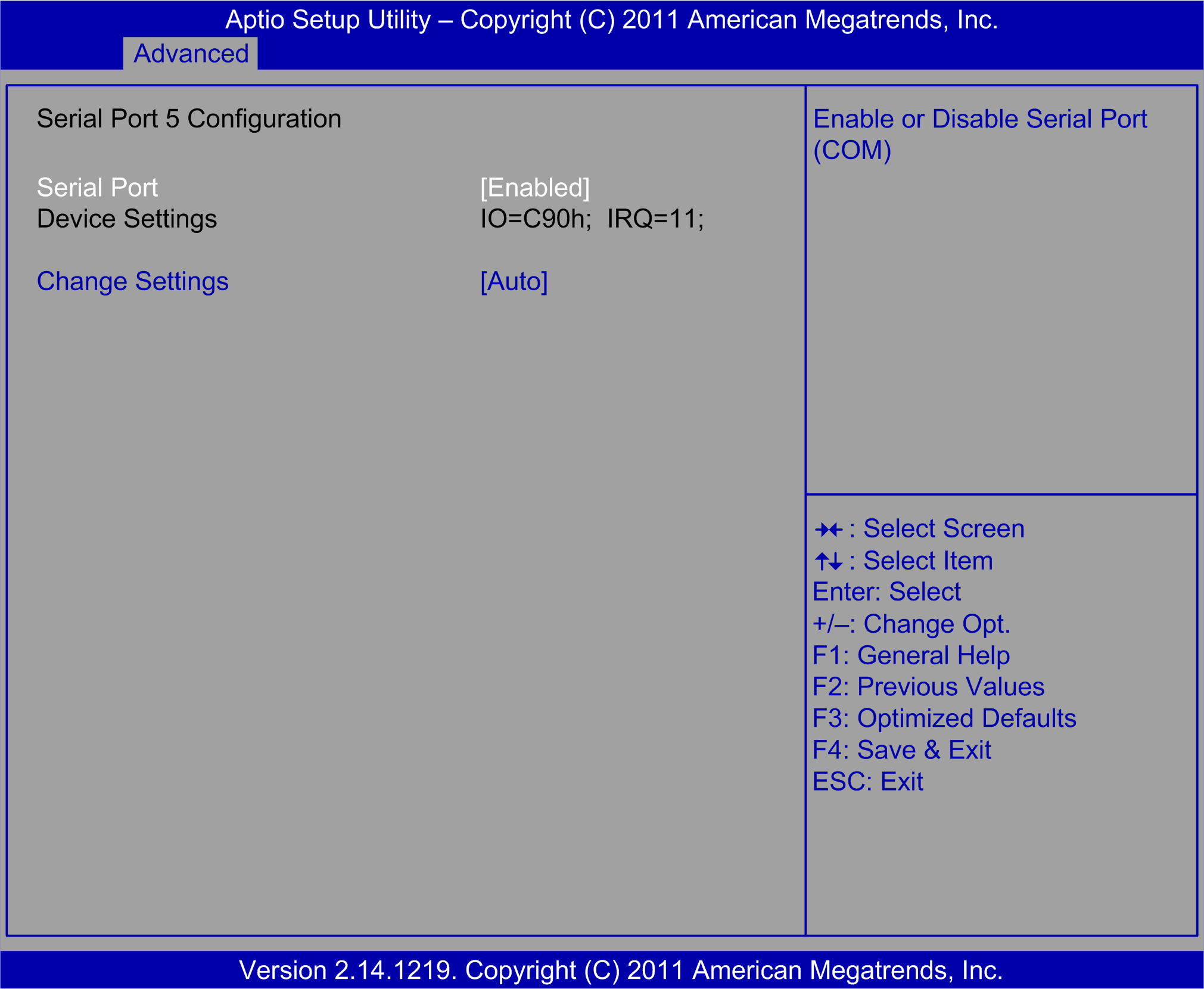
This table shows the Serial Port 5 Configuration options:
|
BIOS setting |
Description |
|---|---|
|
Serial Port |
Enables or disables the serial port 5. |
|
Change Settings |
Selection of the optional settings for the serial port 5. |
Serial Port 6 Configuration submenu:

This table shows the Serial Port 6 Configuration options:
|
BIOS setting |
Description |
|---|---|
|
Serial Port |
Enables or disables the serial port 6. |
|
Change Settings |
Selection of the optional settings for the serial port 6. |
Serial Port Console Redirection Submenu
The Serial Port Console Redirection submenu:

This table shows the Serial Port Console Redirection option:
|
BIOS setting |
Description |
|---|---|
|
Console Redirection |
Enables or disables the console redirection feature. |
The CPU PPM Configuration submenu:

This table shows the CPU PPM Configuration options:
|
BIOS setting |
Description |
|---|---|
|
EIST |
Enables or disables the Intel CPU SpeedStep. |
|
Turbo Mode |
Performance: [Enabled] |